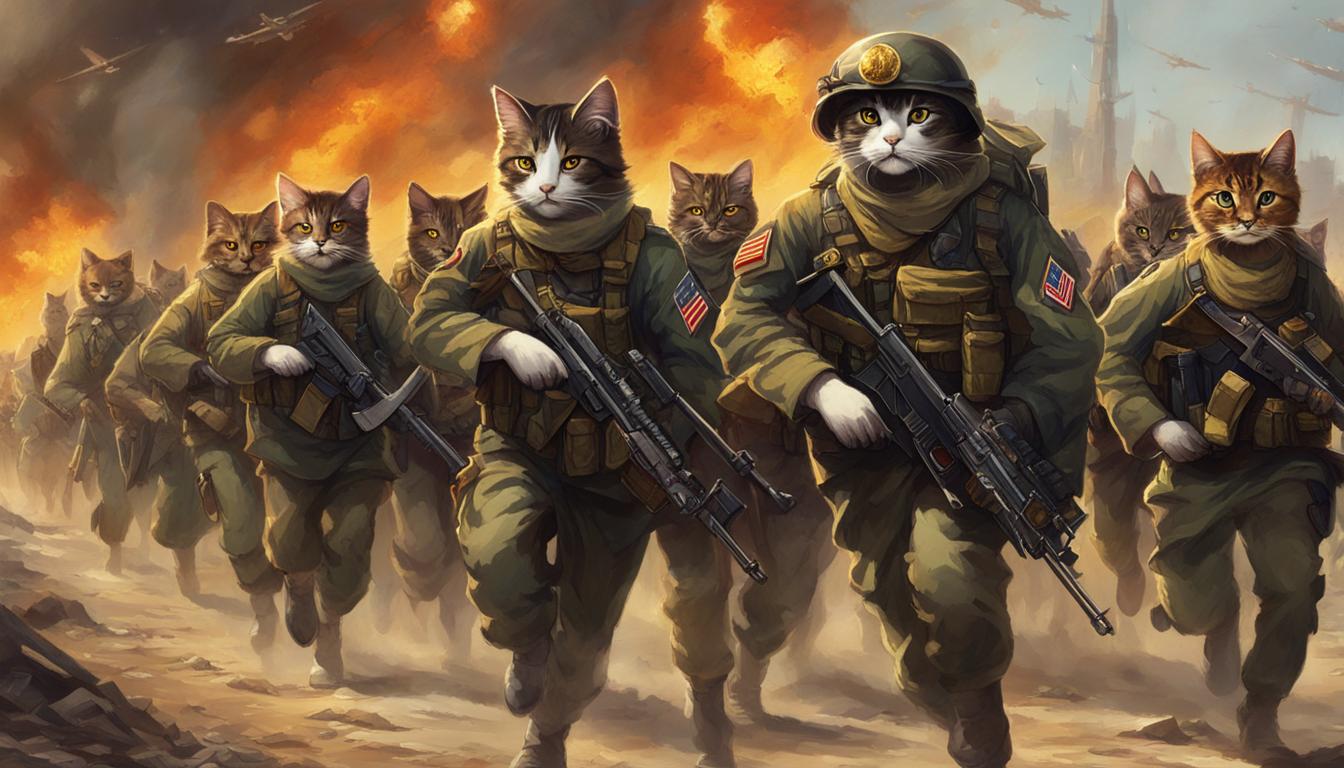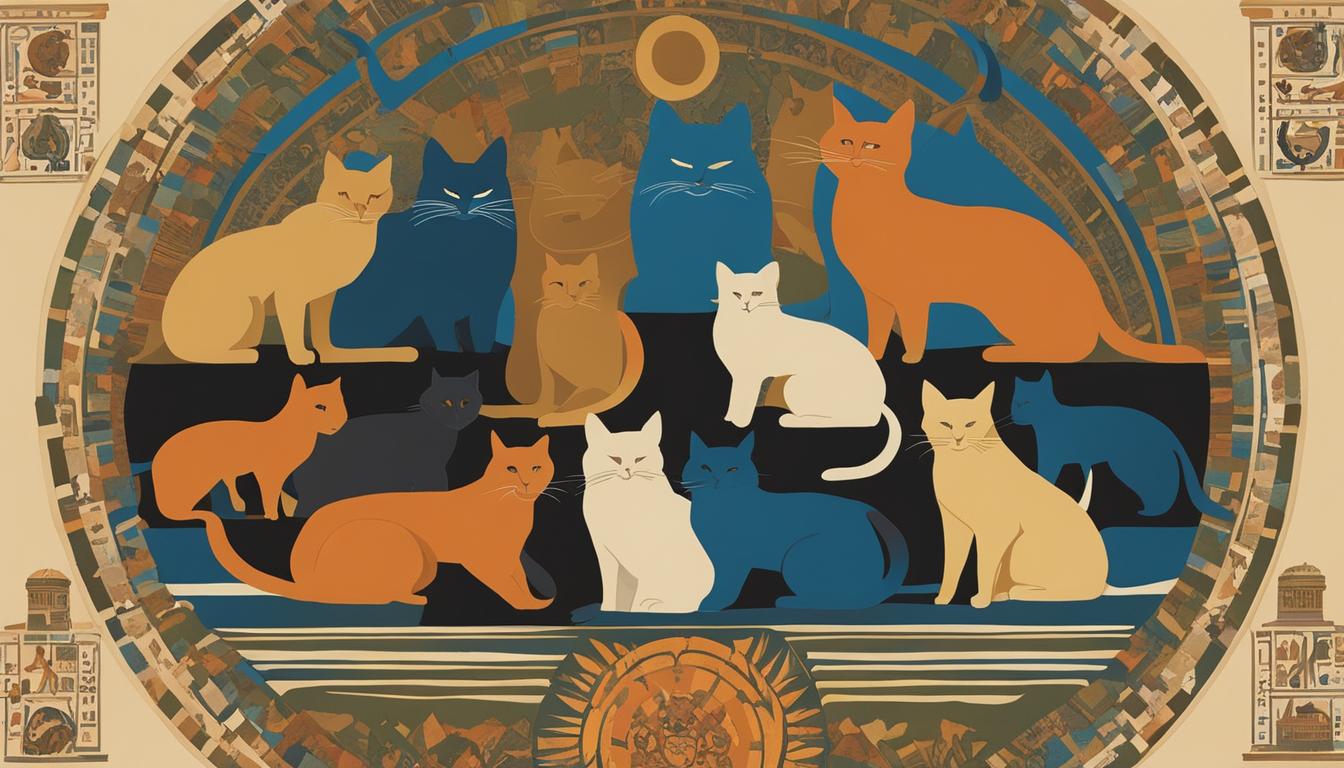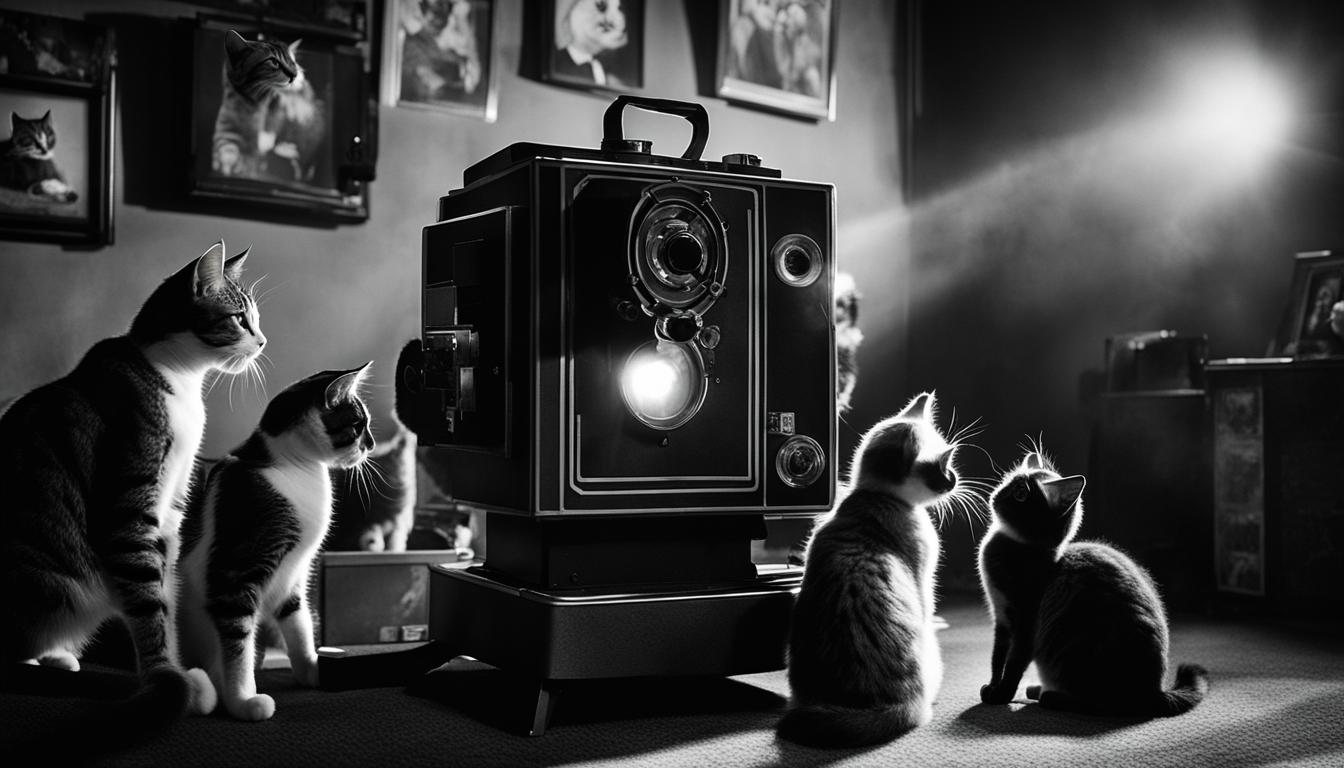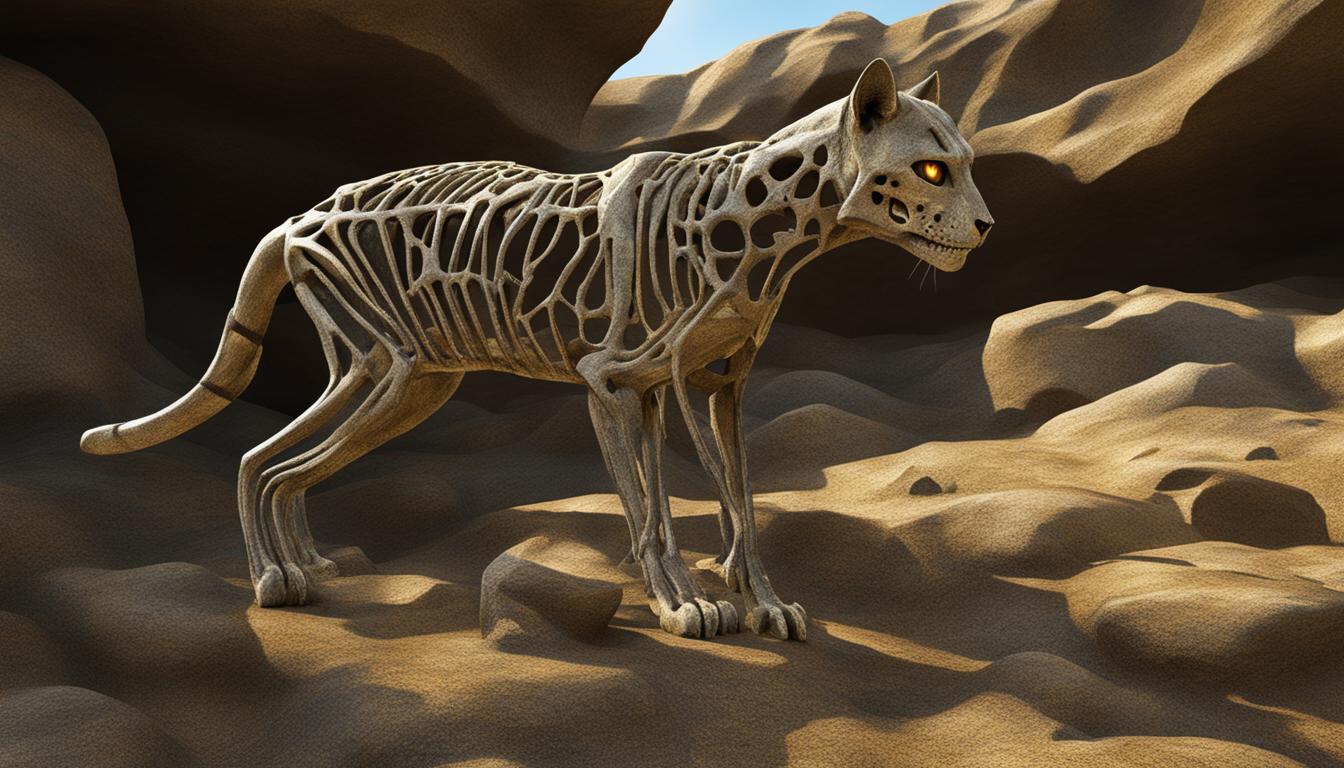When we think of war heroes, we often imagine courageous soldiers, strategists, and leaders. But what about our feline companions who have stood by soldiers’ sides throughout history? Yes, you heard it right – cats have played a vital role in military history as both companions and mascots to troops around the world.
From ancient civilizations to modern conflicts, these furry warriors have brought comfort, companionship, and even strategic advantages to soldiers on the frontlines. Their tales of bravery and loyalty are nothing short of extraordinary.
Key Takeaways:
- Cats have been cherished companions and mascots in military history.
- They provide comfort, companionship, and practical assistance to soldiers.
- Cats have served in ancient wars, World War I and II, and even modern conflicts.
- Some famous war cats have become legends, capturing the hearts of their human counterparts.
- These feline heroes deserve their place in the annals of military history.
Cats in Ancient Wars: From Egypt to Persia
When we think of cats in war, ancient Egypt immediately comes to mind. The Egyptians held cats in the highest regard, considering them sacred and even imposing the death penalty for anyone who harmed one. Cats were seen as protectors and symbols of good luck, making them an integral part of Egypt’s ancient civilization.
But cats’ influence didn’t stop within the borders of Egypt. In fact, their presence extended far beyond, into the realm of warfare. The Persians, known for their shrewd tactics, utilized the power of the Egyptian cat goddess, Bastet, to their advantage during the Battle of Pelusium. By bringing thousands of cats onto the battlefield, the Persians exploited the Egyptians’ reverence for the feline creatures, ultimately forcing their surrender.
“The Persians knew that the Egyptians held cats in high esteem. Using them as psychological weapons was a stroke of genius.” – Military historian, Dr. Emily Collins
These ancient wars demonstrate the extraordinary role that cats played in military conflicts. Their symbolism and cultural significance brought about strategic advantages, altering the course of battles. Cats, once considered household companions, became powerful symbols of conquest and psychological warfare.
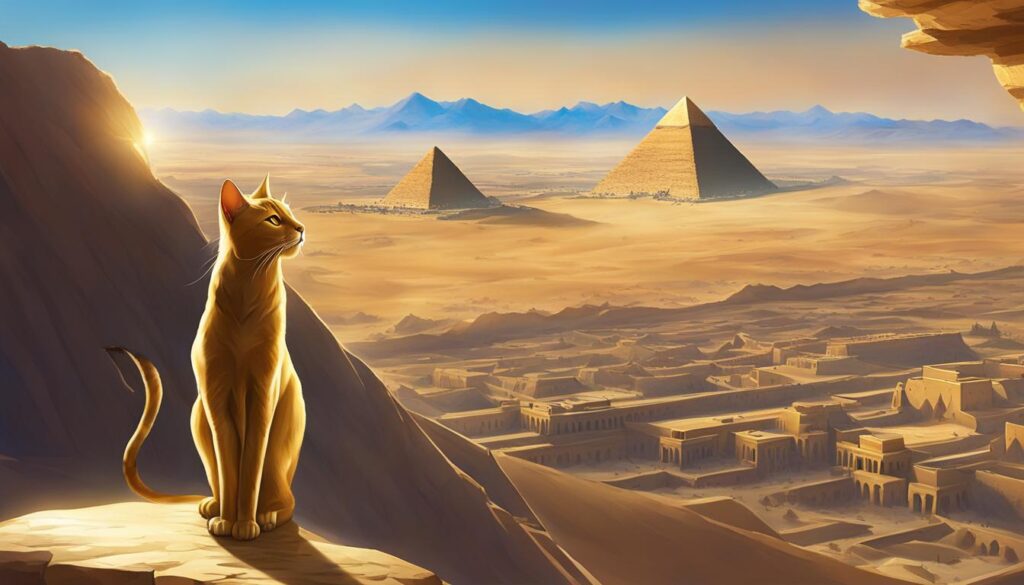
Notable Egyptian Cat Deities:
- Bastet: The goddess of home, fertility, and protection, often depicted with the head of a lioness or domestic cat.
- Sekhmet: The warrior goddess with the head of a lioness, believed to have the power to ward off evil spirits and protect the pharaoh.
- Mafdet: The goddess associated with justice and execution, often portrayed as a fierce cat or feline-shaped creature.
Table: Cats in Ancient Warfare
| Ancient Civilizations | Cats’ Role in Warfare |
|---|---|
| Egypt | Sacred symbols, psychological warfare |
| Persia | Exploitation of Egypt’s reverence for cats |
| Greece | Warship companions for ancient Greek sailors |
| Rome | Cats brought onto the battlefield for their symbolic power |
As we delve deeper into the annals of military history, it becomes clear that cats were not mere bystanders but active participants in ancient wars. From their elevated status in Egypt to their strategic deployment in Persia, cats left an indelible paw print on the battlefield.
Cats in World War I: Comfort and Mascots
When it comes to World War I, cats played a vital role in providing comfort and companionship to soldiers on the frontlines. These feline companions became beloved mascots and brought a sense of normalcy amid the chaos of war.
Throughout the trenches and aboard ships, cats were known to relieve stress, catch mice, and boost morale. They were treasured members of the crew, offering a much-needed respite from the horrors of battle. Their presence provided soldiers with a connection to home and a source of entertainment and companionship during difficult times.
One famous example is “Stubby,” a cat who served with the U.S. Army in France. Stubby had an uncanny ability to detect gas attacks, alerting troops and potentially saving lives. His companionship and bravery earned him the rank of sergeant, making him the first cat to be officially enlisted in the U.S. Army.
Cats as Military Mascots
Alongside their comforting presence, cats also became popular mascots during World War I. These mascots represented camaraderie and offered a sense of morale to troops. One well-known mascot was “Simon,” a ship’s cat aboard the HMAS Encounter, an Australian warship. Simon earned the Dickin Medal for bravery in the presence of the enemy, making him the only cat to receive this prestigious award.
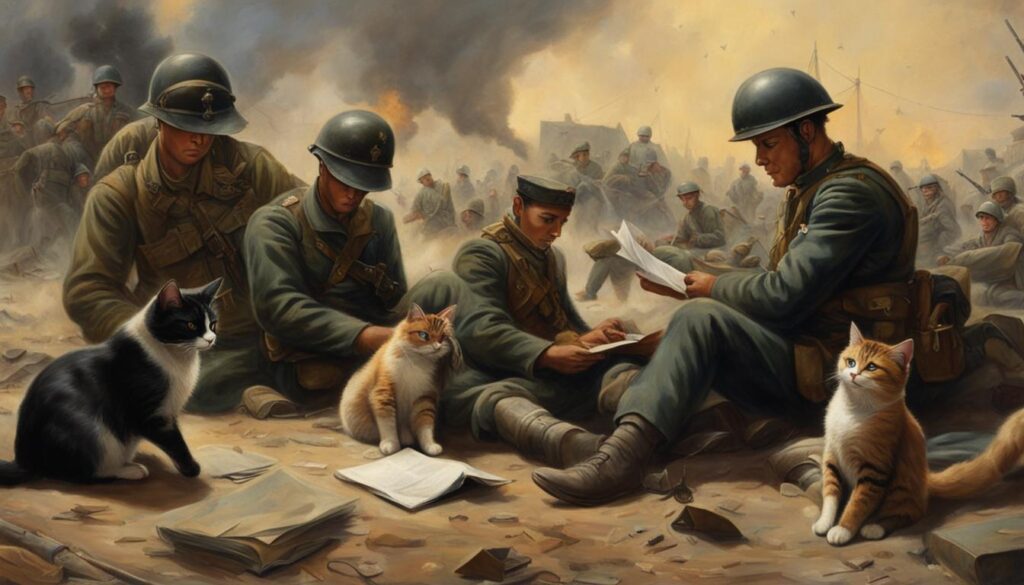
| Military Mascots | Role |
|---|---|
| Tiddles | Royal Navy mascot, sailed over 30,000 miles during WWII |
| Stubby | U.S. Army mascot, detected gas attacks and saved lives |
| Simon | HMAS Encounter mascot, awarded the Dickin Medal for bravery |
These mascots brought comfort and a sense of normalcy to the soldiers, reminding them of the bond between humans and animals. In times of war, the presence of these furry companions offered much-needed solace and support.
Cats in World War II: Mascots and Rodent Control
In World War II, cats continued to play crucial roles as both mascots and rodent controllers. These furry companions were often adopted by soldiers and sailors to keep the population of rats and mice under control on ships, in barracks, and in military field offices. The presence of cats provided practical assistance by ensuring the hygiene and cleanliness of these military environments, while also boosting morale among the troops.
One of the most notable examples of a feline mascot during World War II was “Unsinkable Sam,” also known as “Oscar.” This resilient cat survived the sinking of three separate ships during the war – the German battleship Bismarck, the British destroyer HMS Cossack, and the British aircraft carrier HMS Ark Royal. His survival earned him the title “Unsinkable Sam” and he became a symbol of good luck and resilience for the sailors who served alongside him.
Rodent control was another essential role that cats played during the war. With their natural hunting instincts, cats were highly effective in keeping the populations of rats and mice in check. These pests posed significant health risks to soldiers, as they could carry diseases and damage supplies. The cats’ ability to rid military spaces of these pests not only helped prevent the spread of disease but also protected valuable resources.
“The presence of cats in military environments during World War II was invaluable. Not only did they provide companionship to soldiers, but they also served as efficient and reliable pest controllers. Their ability to keep rodents at bay ensured a safer and healthier environment for the troops.” – Military historian
| Cat | Role | Notable Achievements |
|---|---|---|
| Simon | Ship’s Cat on HMS Amethyst | Received the Dickin Medal for bravery after surviving an attack and helping to clear the ship of rats |
| Conrad | Ship’s Cat on HMS Hermione | Survived the sinking of the ship and was rescued by sailors from the water |
| Tiddles | Ship’s Cat on HMS Victorious | Sailed over 30,000 miles during World War II, providing comfort to the crew |
These examples of heroic cats in World War II highlight the incredible bond formed between humans and felines during times of conflict. Their presence not only brought comfort and companionship to soldiers but also had tangible benefits in terms of rodent control and overall hygiene. The stories of these valiant cats are a testament to the unique and important role they played in military history.
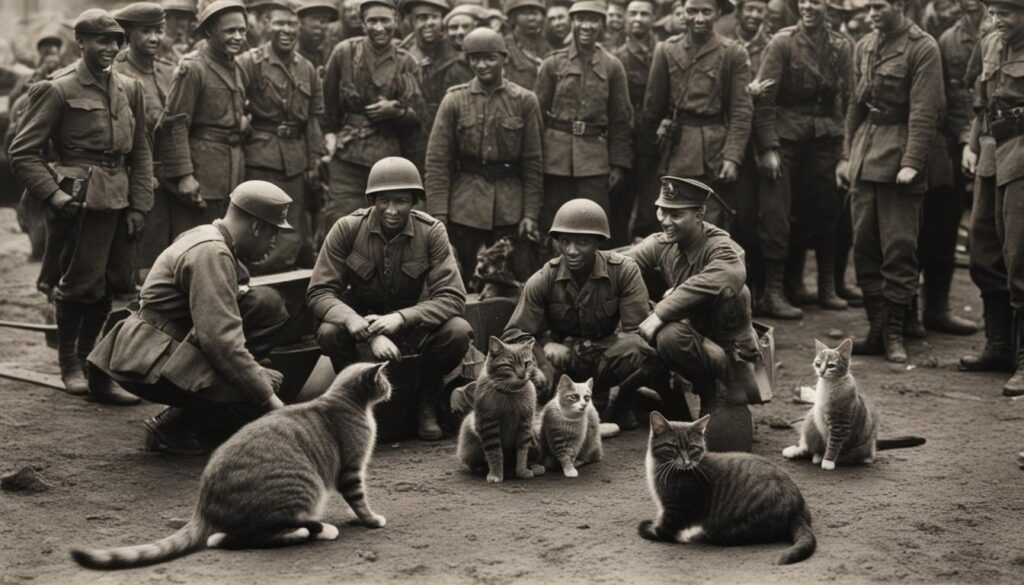
Famous War Cats and Their Achievements
Throughout history, there have been many famous wartime cats who have made significant contributions to armed conflicts. These feline heroes have captured the hearts of their human companions and become legends in their own right. From their courageous acts on the battlefield to their unwavering loyalty and companionship, these cats have left a lasting impact on military history.
One such legendary war cat is Tiddles, who sailed over 30,000 miles with the Royal Navy during World War II. Tiddles provided comfort and morale-boosting companionship to the sailors, bringing a sense of normalcy amidst the chaos of war. His presence aboard the ship brought a soothing presence to the crew, reminding them of the warmth and comfort of home.
Another remarkable war cat is Simon, the only cat to ever receive a Dickin Medal for bravery in battle. Simon served aboard the HMS Amethyst during the Chinese Civil War and played a vital role in boosting the morale of the crew. Despite being injured in a missile attack, Simon continued to perform his duties, keeping the ship’s rat population under control and providing a sense of normalcy in a time of turmoil.
“The arrival of Simon was an amazing morale booster … He was a most improper ship’s cat, smoking, fighting—one of the things seafaring cats are supposed to do least of—and refused to catch the rats unless they came close enough to be caught with one paw.”
These examples of famous war cats highlight their bravery, loyalty, and the positive impact they had on the soldiers they served alongside. They remind us of the unique and incredible bond between humans and animals in times of war, and the profound difference a feline companion can make in the lives of those on the frontlines.
| War Cat | Achievement |
|---|---|
| Tiddles | Sailed over 30,000 miles with the Royal Navy, providing comfort to sailors during World War II |
| Simon | Received a Dickin Medal for bravery in battle during the Chinese Civil War, kept the rat population under control aboard the HMS Amethyst |
Cats in Modern Wars: Companions and Distractions
Modern wars have seen the continued presence of cats, serving as companions and distractions to soldiers on the frontlines. One notable example is Private First Class Hammer, who accompanied U.S. Army troops during their deployment to Iraq in 2004. Hammer’s presence provided a much-needed distraction from the harsh realities of war and offered a source of comfort to the soldiers.
“Having Hammer around was like having a piece of home with us,” said Sergeant Johnson, one of the soldiers who served alongside the feline companion. “He provided a sense of normalcy in the midst of chaos and reminded us of the importance of taking care of each other, including our furry friend.”
Cats in modern wars play an important role in maintaining morale. Their presence brings a sense of familiarity and reminds soldiers of home, providing a much-needed emotional support system. Additionally, cats prove to be excellent companions, offering unconditional love and companionship during challenging times.
While the primary role of cats in modern wars is companionship, their presence can also serve as a practical advantage. Cats’ acute senses and hunting instincts make them ideal for rodent control, particularly in military bases and ships where rodents can pose health and safety risks. Their ability to catch and eliminate mice and rats not only contributes to the overall cleanliness and hygiene of the environment but also helps prevent damage to food supplies and equipment.
| Cat Name | War | Role |
|---|---|---|
| Private First Class Hammer | Iraq War | Companion and Distraction |
| … | … | … |
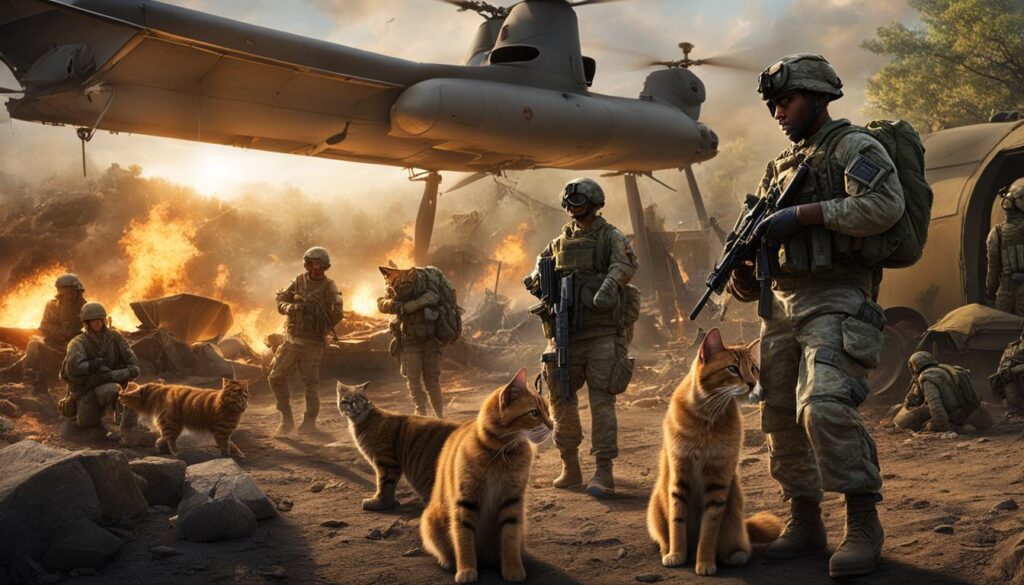
The Importance of Military Mascots
Military mascots, including cats, hold a special place in the hearts of soldiers. They symbolize resilience, loyalty, and companionship in the face of adversity. These feline friends offer emotional support, provide a sense of normalcy, and serve as a reminder of the connection soldiers have to the world beyond the warzone.
In conclusion, cats continue to make a significant impact in modern wars as valued companions and distractions for soldiers. Their presence brings comfort, companionship, and a sense of normalcy in the midst of chaos. These feline heroes play an essential role in maintaining morale and providing practical assistance, making them invaluable assets on the battlefield.
Conclusion
As I look back on the fascinating history of cats in military conflicts, I am amazed by the impact these furry heroes have had on soldiers and their morale. From ancient battles to modern-day wars, cats have provided solace, companionship, and even practical assistance to troops around the world.
Throughout the ages, cats have proven their worth as dedicated companions, serving as mascots and providing comfort in the harshest of conditions. Soldiers in World War I and World War II found solace in the presence of these feline friends, who offered moments of normalcy amid the chaos of war.
Not only have cats provided emotional support, but they have also played practical roles in armed conflicts. Whether it’s their ability to catch rodents on ships or their strategic presence on the battlefield, cats have shown their resourcefulness and intellect.
From legendary cats like Simon, who received a Dickin Medal, to the countless nameless feline companions who boosted the spirits of soldiers, these cats have earned their place as feline heroes in the annals of military history. They remind us of the unique bond between humans and animals, and the unwavering love and support that can be found even in the darkest of times.
FAQ
Did cats play a role in military history?
Yes, cats have played a significant role in military history, serving as companions and mascots to troops around the world.
How were cats used in ancient wars?
In ancient Egypt, cats were revered and worshipped. They were even used as strategic assets, with the image of the Egyptian cat goddess, Bastet, being used to conquer Egypt in the Battle of Pelusium.
What was the role of cats in World War I?
Cats in World War I primarily served as comforting companions and mascots. They provided emotional support to soldiers in the trenches and aboard ships, helping to relieve stress and boost morale.
How did cats contribute in World War II?
In World War II, cats served as mascots and rodent controllers. They were adopted by soldiers and sailors to keep down the population of rats and mice in military environments, while also providing companionship.
Are there any famous war cats?
Yes, there have been many famous war cats throughout history, such as Tiddles, who sailed over 30,000 miles with the Royal Navy, and Simon, the only cat to ever receive a Dickin Medal for bravery in battle.
Do cats still play a role in modern wars?
Cats continue to play a role in modern conflicts by providing comfort and companionship to soldiers. They help maintain morale and serve as a reminder of home during difficult times.
What is the significance of cats in military history?
Cats have made their mark on military history as cherished companions, mascots, and even strategic assets. Their stories highlight the unique bond between humans and animals in times of war.

